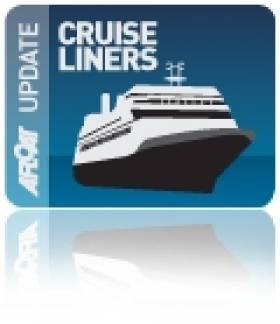Displaying items by tag: Harland & Wolff
Cunard Line Flagship Queen Mary 2 Calls to Cobh
The current liner (QM2) can carry 2,620 passengers and a crew of over 1,200 on a vessel is the longest, tallest and widest of any passenger liner built. The luxury liner has private balconies for nearly 80 per cent of cabins and has an art collection worth £3.5m. To complement these works of art there is the first 'floating planetarium', the largest library at sea, boasting 8,000 hardbacks and also the largest ballroom to grace a ship on the oceans.
Queen Mary 2 was short-listed to be built in Belfast at the Harland & Wolff shipyard, but the contract went to Chantiers d'Atlantique, St. Nazaire on the west coast of France.
Her first visit to Irish waters occurred when she anchored off Dunmore East in 2005, the liner had arrived overnight on a passage from her homeport of Southampton and was on a nine-day cruise of British, Irish and Baltic state ports.
Today's Cobh visit of the 345m long Queen Mary 2 coincided with Ocean Countess, a former 'Cunarder', which is also in the port. The 163m vessel was built in 1976 and launched as their Cunard Countess. She weighs 17,593grt and has a 800 passenger capacity. Last year she joined Cruise & Maritime Voyages (CMV) fleet under charter from Majestic International Cruises Group.
Also at work in Cork Harbour was the excursion vessel Spirit of the Isles which apart from operating River Lee sight-seeing cruises between Cork city-centre and Cobh at the weekends, is running a charter cruise this afternoon to Spike Island. For information about sightseeing trips and chartering click HERE.
‘Bounty’ Joins Belfast’s Titanic Maritime Festival
The US-flagged replica tallship H.M.S. Bounty arrived into Belfast Lough this morning for the Belfast Titanic Maritime Festival (24-26 June), writes Jehan Ashmore.
Measuring some 200 tonnes, the three masted-replica ship of the original H.M.A.V Bounty where the famous mutiny against Captain William Bligh took place in Tahiti in 1789, is to open to the public.
The replica was constructed in Nova Scotia of the original Hull-built vessel for the 1962 MGM film 'Mutiny on the Bounty' starring Hollywood screen legend Marlon Brando.
The Bounty was also used in the filming of Pirates of the Caribbean II and a Lone Wolf Production Group documentary on Blackbeard and has featured in several documentaries.
'Bounty' will be open to visitors (for information www.tallshipbounty.org) and is to be accompanied by the Jubilee Sailing Trust's Lord Nelson (www.jst.org.uk/).
The festival venue is at the Queen's Quay, Abercorn Basin and Arc, behind the Premier Inn Hotel at the Titanic Quarter.
As for the Titanic, tours of the old main offices of the H&W shipyard on the Queen's Road courtesy of the Titanic Quarter Ltd will be open to the public with displays relating to Titanic and Edwardian Fashion.
In addition Titanic Bus Tours lasting two hours which are free are available from the Belfast Welcome Centre, to contact Tel: 028 9024 6609.
For a complete listing of the festival events, dates and opening hours go to www.belfastcity.gov.uk/maritimefestival/index.asp
- Belfast
- Port of Belfast
- Lord Nelson
- Belfast Lough
- Titanic
- Jubilee Sailing Trust
- Titanic Quarter
- Belfast Harbour Commissioners
- Tahiti
- Harland & Wolff
- Belfast Lough News
- MGM
- Hollywood
- Maritime Festivals
- Mutiny on the Bounty
- Captain William Bligh
- Marlon Brando
- H.M.S. Bounty
- H.M.A.V. Bounty
- The Bounty
- MGM Film Studies
- Replica tallship
- Maritime Events
- SS Titanic
- H&W
- JST
- Holiday Inn
- Queen's Quay
- Abercorn Basin
- Titanic Quarter Ltd
- Belfast Welcome Centre
Superfast Sisterships for Stena's Northern Route
Stena will lease the ferries for a three year period from Tallink, the Baltic Sea based shipping group. (Click here for photo of Superfast VIII in ice-flow waters). The charter arrangement includes an option to extend for a further year.
The distance between the new ferry terminal named the 'Loch Ryan Port' at Old House Point (which is just north of Cairnryan) is approx. 8kms apart from Stranraer taking the coastal (A77) road along the Loch that leads onto to Glasgow. At Cairnryan, rivals P&O (Irish Sea) who along with predecessing operators have run services on the route to Larne for several decades.
With a speed of 27-knots, passage times on the new Stena Belfast-Cairnryan route will take 2 hours 15 minutes, this compares to the existing time of 2 hours 50 minutes from Stranraer by conventional ferry and 2 hours taken by the HSS fast-ferry.
As a consequence of Stena operating from Loch Ryan Port, passage times by the Superfast sisters will be reduced by 35 minutes as the Belfast terminal was also relocated in recent years. Though despite the relocated ferry terminals, the Superfast sisters scheduled 2 hours 15 minutes sailings from the new port will be slightly longer compared to the HSS Stena Voyager's 2 hour sailing time from Stranraer.
Also serving the Belfast Stranraer route are the conventional ferries, Stena Caledonia (formerly Sealink's St. David built at Harland & Wolff) and Stena Navigator, that served SeaFrance on Dover-Calais sailings as SeaFrance Manet. When the Superfast sisters replace the HSS Stena Explorer and the conventional ferries, perhaps there will be a new a role for the two vessels in replacing expensive to run fast-craft operated elsewhere.
In the meantime the Superfast pair will maintain running on Tallink's 26-hour Helsinki-Rostock until mid-August. The 2001 German will then undergo an extensive refit of passenger facilities and a new freight-only deck will be incorporated to cater for haulage operators increasing use of higher vehicles and double-deck freight units.
The 'Superfast' vessel naming theme derives from the original owners, Greek operator Superfast Ferries, which sold their Scandinavian operations to Tallink in 2006.


























































